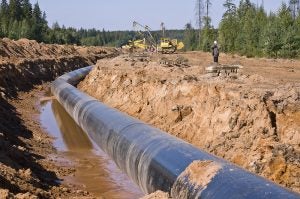4 opportunities for gas utilities to accelerate the energy transition today
 A troubling story recently emerged about a group of gas utilities whose mission is to fight electrification. While the leaked materials alone don’t explain the full extent of the group’s efforts, it was unsettling to see baseless, fear-driven tactics such as “take advantage of power outage fear,” to make people wary of electrification. Instead of blocking progress to safe, affordable, clean energy, gas utilities concerned with the future should be taking steps today to accelerate the energy transition.
A troubling story recently emerged about a group of gas utilities whose mission is to fight electrification. While the leaked materials alone don’t explain the full extent of the group’s efforts, it was unsettling to see baseless, fear-driven tactics such as “take advantage of power outage fear,” to make people wary of electrification. Instead of blocking progress to safe, affordable, clean energy, gas utilities concerned with the future should be taking steps today to accelerate the energy transition.
Several analyses make clear that electrification of commercial and residential buildings will play a predominant role in achieving state climate goals. Take New Jersey, for example, where residential and commercial buildings account for the second largest share of the state’s greenhouse gas emissions. According to modeling done by the state, in order to achieve its climate goals of 80% emission reductions by 2050, residential and commercial sector emissions must be reduced by 89%.
To achieve this level of emission reductions, New Jersey has found that “policies requiring net-zero emissions for new construction must be paired with aggressive requirements for electrification of older residential and commercial buildings as soon as practicable.” In other words, the last thing we should be doing is fighting efforts to electrify.
Electrification of the building sector is not without its challenges. As states achieve their climate goals, natural gas infrastructure once deemed useful may no longer be necessary, and that transition will accelerate over the next decade depending on how fast end uses of the gas system, such as heating and cooking, are electrified. The good news is that there have been some cost-effective technological innovations that will make this transformation possible without compromising consumer experience.
4 opportunities for gas utilities to accelerate the energy transition today Share on XThe problem is that utility regulations, outdated utility business models and tactics to fight electrification are slowing the transition down. These impediments mean that we are still spending large amounts of ratepayer money on new gas infrastructure based on an assumed useful life of 60 years or longer. As one example, New Jersey Natural Gas is requesting rate recovery of millions of dollars of new gas infrastructure investments without any demonstration of how increased investment in the gas system will comport with New Jersey’s Global Warming Response Act.
EDF’s Aligning Gas Regulation with Climate Objectives paper set forth a roadmap for regulators to address these challenges. We made clear that this massive transformation will require thoughtful planning with increased transparency and accountability, ensuring that protections are put in place so that low-income customers are not left holding the bag as wealthier customers leave the gas system to electrify. As detailed in EDF comments before the New York Public Service Commission and the New Jersey Board of Public Utilities, there are a host of opportunities gas utilities have today to start accelerating the energy transition. Here are four:
- Design Super Emitter Programs to Abate the Largest Methane Leaks. Methane, the principal component of natural gas, is a potent greenhouse gas that has more than 80 times the warming power of carbon dioxide over the first 20 years after it reaches the atmosphere. Recent research shows that estimated U.S. methane emissions from gas distribution pipes are about five times greater than projected by the EPA Greenhouse Gas inventory. Importantly, a few “super-emitter” leaks (defined as 10 standard cubic feet or greater) are responsible for a significant share of the local gas system leakage. Utilities should design Enhanced High Emitter Programs, targeting repair of large leaks to deliver the most meaningful emissions reductions first.
- Assess Opportunities to Retire Leak Prone Pipe. Gas utilities will need to give careful thought to the replacement of leak prone pipe, balancing the need to maintain a safe system with the high costs of replacement. Utilities should work with interested stakeholders to study these issues and develop a thorough assessment of costs, site feasibility, community outreach, GHG emissions reduction potential and financing/ratemaking changes needed to facilitate the retirement of portions of their systems. As Massachusetts is currently studying, high electrification scenarios could result in dramatic reductions in total gas utility sales, necessitating a thorough evaluation of impacts. Decisions must be made in conjunction with low-income customers and frontline communities to understand their priorities and needs.
- Conduct Thorough GHG Assessments. Traditional gas supply planning has largely ignored any assessment of GHG emissions. But regulators are starting to recognize the importance of calculating and reporting GHG emissions associated with all solutions — both supply-side and demand-side. EDF commissioned MJ Bradley & Associates to develop the Gas Company Climate Planning Tool, which will allow regulators, utilities and interested stakeholders to understand and assess the lifecycle GHG emissions of gas utilities. Utilities should use this tool to evaluate different portfolios of gas supply options against each other and to evaluate the effects of a proposed portfolio on state-wide GHG reduction goals.
- Consider Pilots to Test Innovation. Gas utilities are starting to explore different types of pilot programs to test innovative solutions — from gas demand-response programs to geothermal heating and cooling. In designing new pilot programs, utilities should demonstrate how these exploratory efforts adhere to the principles of accountability, scalability, equity and emission reductions.
Several states are making significant strides to set limits on greenhouse gas emissions and to achieve meaningful pollution reductions. Instead of impeding progress in these states, it’s time for gas utilities to step up and embrace today’s clean energy future.











